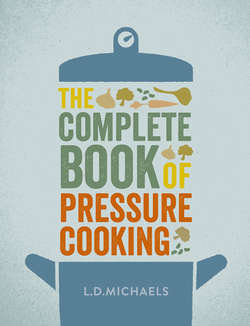Читать книгу The Complete Book of Pressure Cooking - L.D. Michaels - Страница 24
THE RECIPES
ОглавлениеIn the next chapters of this book, which follow the usual “menu” order of foods and dishes, I have more or less followed a set pattern:
1 BASIC METHOD AND TIMINGS. Usually I will cover not only fresh food but also frozen, dried and freeze dried. Dried foods are those that have had their moisture taken away from them naturally, by exposure to the sun, such as pulses. Freeze-dried (dehydrated) foods have been treated to a rapid freezing technique and include things like “instant” dried peas, peppers, onions and so forth. Usually, dried foods take longer to reconstitute than freeze-dried ones.
2 TABLES
3 SPECIAL METHODS OF COOKING including nutritional recommendations.
4 MORE ADVENTUROUS RECIPES that you may like to try or which will inspire you to adapt and invent your own.
Good cooking begins with good buying. Pressure cooking can sometimes rescue slightly stale or “old” food, but the best results, as with the best of conventional cookery, come from fresh, good ingredients. Buy lively looking vegetables, properly hung meat and firm fish.
Timing is for cooking under pressure, after proper preparation, and begins when the cooker has been brought to the right internal temperature and pressure. Unless otherwise stated, this is at 15 psi (H), the normal operating level. Periodically I will remind you to adjust if your pressure cooker operates at a lower level.
What governs cooking time most of all is the speed of heat and steam penetration. Small pieces cook more rapidly than big ones. It is not the total weight of the ingredient but the size of the individual pieces that counts: 2kg (4½lb) carrots thinly sliced, diced or cut into matchsticks (allumettes) will cook more rapidly than a single carrot, whole and uncut, weighing 250g (9 oz). Make all the portions of any one ingredient roughly the same size.
Usually only pieces of meat and fish that are served entire (and of course cooked whole) are timed by weight.
Adjust all cooking times slightly for personal preference. Some people prefer their vegetables crisp (al dente), while others like them plump and juicy; the latter result takes a little more cooking time – you’ll soon learn.
I think it is worth paying a little attention to the final appearance of the food. The saving in cooking time gives you more time to cut up the vegetables into nice-looking pieces and shapes – carrots can become circles, ellipses, long thin sticks; celery can be cut into comma shapes. The extra effort required is minimal, but the effect on the final appearance on the serving plate is dramatic. Quick recipes don’t mean that the food has to be sloppy or unattractive.
Most of the recipes are for four people unless otherwise stated.
